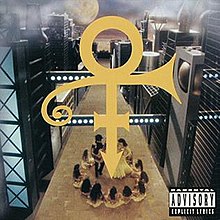| Love Symbol | ||||
|---|---|---|---|---|
 | ||||
| Studio album by | ||||
| Released | October 13, 1992 | |||
| Recorded | September 11, 1990; December 1990; May 12, 1991; September 18, 1991 – March 1992; July 1992[citation needed] | |||
| Genre | ||||
| Length | 75:00 | |||
| Label | Paisley Park, Warner Bros. | |||
| Producer | Prince and the New Power Generation | |||
| Prince chronology | ||||
| ||||
| Alternative cover | ||||
 Cover without the symbol | ||||
| Singles from Love Symbol | ||||
| ||||
Love Symbol is the fourteenth studio album by American recording artist Prince,[2] and the second of two that featured his backing band the New Power Generation. It was released on October 13, 1992, by Paisley Park Records and Warner Bros. Records.[3] It was originally conceived as a "fantasy rock soap opera" with various spoken segues throughout, and contains elements of R&B, funk, pop, rock, and soul.[4]
The official title of the album is an unpronounceable symbol depicted on its cover art, which Prince copyrighted under the title "Love Symbol #2", and adopted as his stage name from 1993 to 2000 to protest his treatment by Warner Bros. Records (which had refused to steadily release his back catalog of unreleased music, and trademarked his given name for promotional purposes).[5][6] The release has been referred to under titles such as Love Symbol, Symbol Album, or Symbol.[2]
Its first two singles, "Sexy MF" and "My Name Is Prince", achieved modest success on the US pop chart, though both made the top ten in the United Kingdom. Conversely, the third single, "7", was not as successful in the United Kingdom, but was a top ten hit in the United States.
- ^ Erlewine, Stephen Thomas. "Prince & the New Power Generation: The Love Symbol Album" at AllMusic. Retrieved 25 October 2009.
- ^ a b Carter, Andrew (June 23, 1999). "The People Formerly Known as Fans". City Pages. Archived from the original on October 14, 2008. Retrieved July 5, 2018.
- ^ "Prince & The New Power Generation Discography". Discogs. Retrieved April 15, 2009.
- ^ Willman, Chris (October 11, 1992). "Prince's Latest Fleshed-Out Fantasy". Los Angeles Times. ISSN 0458-3035. OCLC 3638237. Archived from the original on July 25, 2012. Retrieved July 6, 2017.
- ^ Lussenhop, Jessica (April 22, 2016). "Why did Prince change his name?". BBC News. Retrieved May 20, 2020.
- ^ Rhodes, Margaret (April 22, 2016). "The Fascinating Origin Story of Prince's Iconic Symbol". Wired. ISSN 1059-1028. Retrieved May 20, 2020.